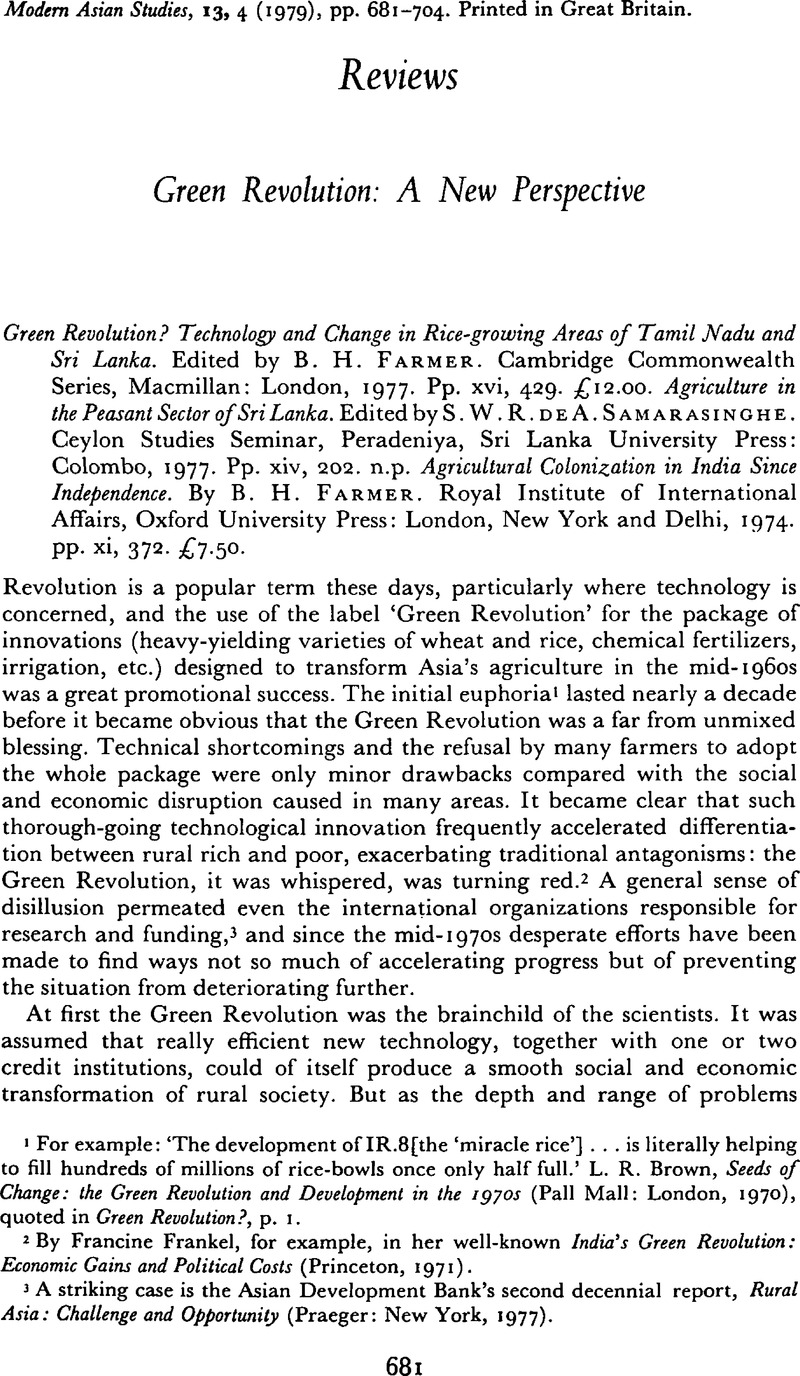Published online by Cambridge University Press: 28 November 2008

1 For example: ‘The development of IR. 8 [the ‘miracle rice’] … is literally helping to fill hundreds of millions of rice-bowls once only half full.’ Brown, L. R., Seeds of Change: the Green Revolution and Development in the 1970s (Pall Mall: London, 1970), quoted in Green Revolution?, p. 1.Google Scholar
2 By Frankel, Francine, for example, in her well-known India's Green Revolution: Economic Gains and Political Costs (Princeton, 1971).Google Scholar
3 A striking case is the Asian Development Bank's second decennial report, Rural Asia: Challenge and Opportunity (Praeger: New York, 1977).Google Scholar
4 Song population figures are quoted in numbers of households rather than individuals, which makes exact interpretation difficult. The census of 1080, that is before the government had been driven south by Jürchen invaders, put the population at 14·5 million households, of which 10 million lived in the southern provinces; by 1173, when the Jürchen Jin dynasty ruled North China, the total population of both Song and Jin was 18.75 million households, of which 12 million lived in the south under Song rule.
5 Champa rices had the additional advantage of requiring less water than most Chinese strains, which meant that they were drought-resistant and could be used in areas of comparatively low rainfall. ‘In 1012, when the Lower Yangzi and Huai River regions suffered from drought, 30,000 bushels of Champa seeds were shipped from Fujian to be distributed in the drought areas. To familiarize peasants with this valuable strain the government circulated pamphlets in which the methods for cultivating it were explained.’ Ho, P. T., Studies on the Population of China, 1368–1953 (Harvard, 1959), p. 170.CrossRefGoogle Scholar
6 On extension services and ‘rural instructors’ see Lewin, Günter, Die Erste Fünfzig Jahre der Song-Dynastie in China (Akademie-Verlag: Berlin, 1973), p. 73.Google Scholar
7 Wang Yuhu gives a detailed list of agricultural works published in the Song and other dynasties in Zhongguo nongxue shulu (A Bibliography of Chinese Agricultural Texts) (Shanghai, 1964).Google Scholar The proliferation of agricultural works from Song times onwards was made possible by the spread of printing.
8 In particular Wang Anshi's much contested ‘Young sprouts’ loans; see Ichio, Higashi, Ō Anseki Shinpō no Kenkyū (A Study of Wang Anshi's New Policies) (Kazamo shobo: Tokyo, 1970), pp. 539–620.Google Scholar
9 On the resettlement of refugees on agricultural colonies and the establishment of military farms see Lewin, pp. 79ff.Google Scholar
10 Jiannong, Li, Song Than Ming Jingji Shigao (A Draft Economic History of the Song, Yuan and Ming Dynasties) (Peking, 1957), p. 14 describes Fan Chengda's reclamation of large stretches of marshy coastline in Jiangsu from 1026; Wang Zhen's Nong shu (Agricultural Treatise) of 1313 describes various methods of land reclamation in Ch. 11, including poldered fields, floating fields and terraces.Google Scholar On government irrigation schemes in the Song see Chi, C-T., Key Economic Areas in Chinese History (Allen and Unwin: London, 1936), Ch. 3.Google Scholar
11 Ho, p. 171.Google Scholar
12 Lewin, , p. 44.Google Scholar
13 Zhen, Wang, Nong shu, Chs 8–12, gives some idea of the range of Song agricultural implements.Google Scholar
14 Ibid., Chs 19–20; Li, pp. 28ff.
15 Li, p. 17.Google Scholar
16 Ibid., pp. 17, 26–7; Li suggests that while powerful landlords were able to reclaim marshy land in the valleys, which they turned into fertile dyked and irrigated fields making use of their tenants’ labour, the poor built terraced fields on the hillsides which, as unregistered land, were not liable to taxation.
17 Shiba, Y. (trs. Elvin, M.), Commerce and Society in Sung China (Michigan, 1970).Google Scholar
18 For example, by the substitution for dryland wheat or millet of irrigated rice in North China, or the introduction of northern crops to the Yangzi area; Ho, p. 176.Google Scholar
19 King, F. H., Farmers of Forty Centuries (Cape: London, 1927);Google ScholarBuck, J. L., Chinese Farm Economy (Chicago, 1930),Google Scholar and Land Utilisation in China (Shanghai, 1937);Google ScholarHinton, W., Fanshen: a Documentary of Revolution in a Chinese Village (Penguin, 1972).Google Scholar
20 See Ho, pp. 136 ff;Google ScholarRawski, E. Sakakida, Agricultural Change in the Peasant Economy of South China (Harvard, 1972), Ch. 5 documents this process in Hunan in the Quing dynasty.CrossRefGoogle Scholar
21 Javanese and Balinese methods are said to be up to 400 per cent more productive than those of the Outer Islands; Rodney Tasker, ‘Indonesia's transmigration project’, Far Eastern Economic Review, 9 March 1979, pp. 28–30.Google Scholar